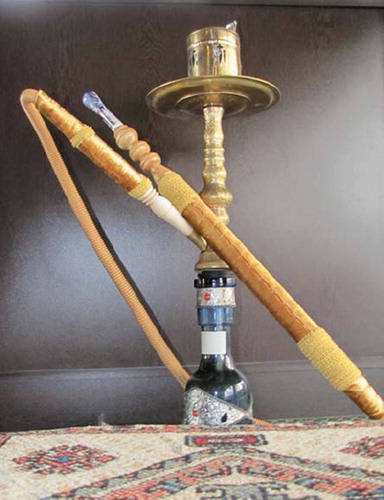Abstract
The water pipe is a means of tobacco consumption widespread in Turkey and Arab countries. We present two patients brought to our emergency department due to a syncopal attack secondary to carbon monoxide toxicity following water pipe use. This rare form of poisoning should be borne in mind by emergency physicians as a differential diagnosis in water pipe smokers. Water pipes should be used where there is adequate ventilation.
Keywords::
Introduction
The water pipe is a form of tobacco consumption, also known as the nargileh, shisha, hookah, and hubble bubble (). Its use began in India, and it has been used for a long time in Iran and the Mediterranean region, among Arabs and Turks. In recent years, it has also been increasingly used by young people in Europe and America.Citation1 Carbon monoxide (CO) poisoning is a potential cause of accidental poisoning with high mortality and morbidity, and may cause difficulties for emergency physicians in terms of diagnosis.Citation2 In this case report, we describe two patients who developed syncope due to Carbon monoxide (CO) poisoning associated with water pipe smoking.
Cases
Case 1
A 21-year-old male was brought to the emergency department with syncope. His history revealed that he had smoked a water pipe in a closed environment 3 h previously and that he fainted immediately after leaving that environment. On admission to the emergency department, he was nauseated, vomiting, and complained of headache, lethargy, and pain in his muscles. He was confused, with a Glasgow Coma Score (GCS) of 13. Cerebellar tests were normal. Vital findings were as follows: arterial blood pressure 110/85 mmHg, pulse 16 beats per minute, body temperature 36.3°C, and respiratory rate 16 breaths per minute. He had no history of drug use or structural heart disease. Serum glucose was 95 mg/dl. His arterial blood gas analysis showed pH 7.40, O2 saturation 98%, and carboxyhemoglobin (COHb) level 26% (CO normal level is 0.5–1.5%). Routine biochemical analysis was normal. CO poisoning associated with water pipe smoking was suspected and 8l/min 100% O2 initiated. Symptoms normalized at follow-up in the emergency department and COHb decreased to 1.4%. After 12 h observation, the patient was discharged from the emergency department.
Case 2
A 20-year-old woman was brought to the emergency department with headache, nausea, lethargy, and syncope. Her history showed that her symptoms began after smoking a water pipe. Her GCS was 15. Vital findings were blood pressure 120/80 mmHg, pulse 103 beats per minute, and respiratory rate 15 breaths per minute. No abnormalities were determined at physical examination, and her neurological examination was normal. The patient's routine biochemical values were normal. Arterial gas analysis was pH 7.416, pCO2 38.4, pO2 101, HCO3 24.7, O2 saturation 99.3%, and COHb level 27.5%. Water pipe-associated CO intoxication was suspected and 8 l/min O2 therapy initiated. Symptoms normalized at follow-up in the emergency department and COHb decreased to 1.5%. After 12 h observation, the patient was discharged.
Discussion
The water pipe is used to smoke tobacco. The tool enables the user to inhale the smoke by passing it through water. People often imagine that the smoke passed through water is cooled and filtered. However, every water pipe session is thought to represent the equivalent of exposure to the smoke from 100 to 200 cigarettes.Citation3 The water pipe gives off charcoal smoke as well as the tobacco smoke being inhaled, which leads to a high level of CO gas in the environment.
In Turkey, the most frequent cause of CO poisoning is exposure to stove smoke. Other common causes of CO exposure are fires, vehicle exhaust, and cigarette smoke.Citation4,Citation5 There is normally a small amount of COHb in the bloodstream from the catabolism of hemoglobin and its level may be 1–2%. However, the level of COHb is 5–6% for cigarette smokers and 10% for water pipe smokers.Citation6,Citation7 We have to note that symptoms may not correlate well to COHb levels. The suspicion of exposure is important and diagnosis should be supported with blood COHb levels.Citation8
Emergency physicians should remember CO poisoning as a differential diagnosis when water pipe users present with syncope. All kinds of tobacco consumption cause increased smoke exposure in the enclosed environment. Water pipe smokers are exposed to charcoal smoke in addition to tobacco smoke, therefore the risk of CO poisoning is increased. Water pipes should only be used where there is adequate ventilation.
Declaration of interest
The authors report no conflicts of interest. The authors alone are responsible for the content and writing of the paper.
References
- Sivaramakrishnan VM. Tobacco and Areca Nut. Hyderabad: Orient Blackswan; 2001: 4–5.
- Marc B, Bouchez-Burvy A, Wepierre JL, Boniol L, Vaquero P, Garnier M. Carbon-monoxide poisoning in young drug addicts due to indoor use of a gasoline powered generator. J Clin Forens Med 2001; 8: 54–56.
- Lim BL, Lim GH, Seow E. Case of carbon monoxide poisoning after smoking shisha. Int J Emerg Med 2009; 2:121–122.
- Hardy KR. Pathophysiology and treatment of CO poisoning. J Toxicol Clin Toxicol 1994; 32:613–629.
- Guven M, Sungur M, Tanrıverdi F, Eser B, Kekeç Z. Evaluation of patients with acute intoxication. Turk J Med Sci 2002; 32: 169–172.
- Herman LY. Carbon monoxide poisoning presenting as an isolated seizure. J Emerg Med 1998; 16:429–432.
- Zahran FM, Ardawi MS, Al-Fayez SF. Carboxyhemoglobin concentrations in smokers of sheesha and cigarettes in Saudi Arabia. Br Med J (Clin Res Ed) 1985; 291:1768–1770.
- Sen S, Peltz C, Beard J, Zeno B. Recurrent carbon monoxide poisoning from cigarette smoking. Am J Med Sci. 2010; 340:427–428.

